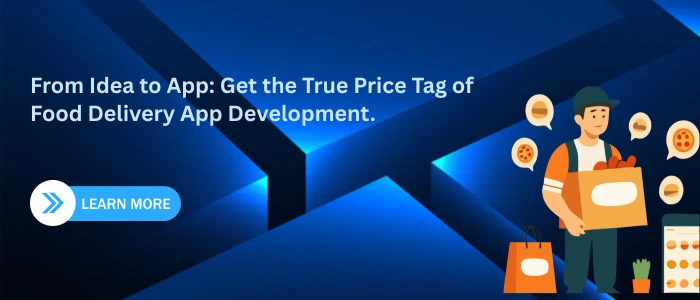Introduction
Estimated Cost Breakdown to Build a Food Delivery App
| Development Stage | MVP Development | Mid-Level App | Full-Scale App |
|---|---|---|---|
| Estimated Cost | $10,000 – $20,000 | $20,000 – $40,000 | $40,000 – $80,000+ |
| Timeline | 4–6 weeks | 8–10 weeks | 14–18 weeks |
| Features Included |
|
|
|
| Security | Basic data encryption | Secure authentication & token-based access |
|
| Integrations | Single payment gateway |
|
|
| Analytics | Basic usage reports | Order & revenue insights |
|
Factors That Influence Final Cost
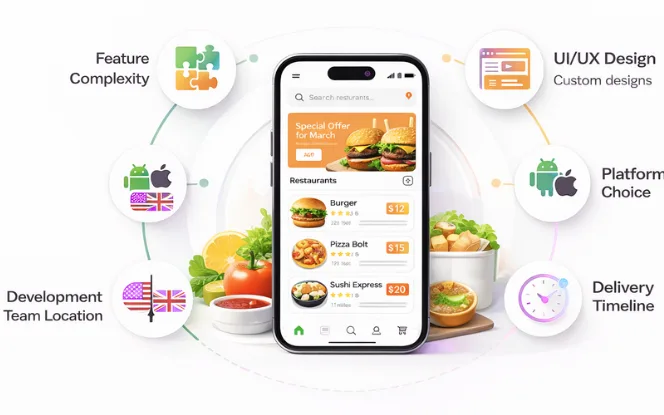
- Feature Complexity: More features = higher cost
- UI/UX Design: Custom designs cost more than templates
- Platform: Android, iOS, or both
- Development Team Location: U.S./U.K. developers charge more than Eastern Europe or Asia
- Timeline: Faster delivery often incurs higher cost due to extended work hours
Each of these factors should be considered in your food delivery app pricing guide, as they collectively define how feasible your development goals are within budget and timeline expectations. Dive deeper into Understanding the Budget for Mobile App Development by App Type
Key Features Required in a Food Delivery App
1. Customer App Features:
User Registration & Profiles
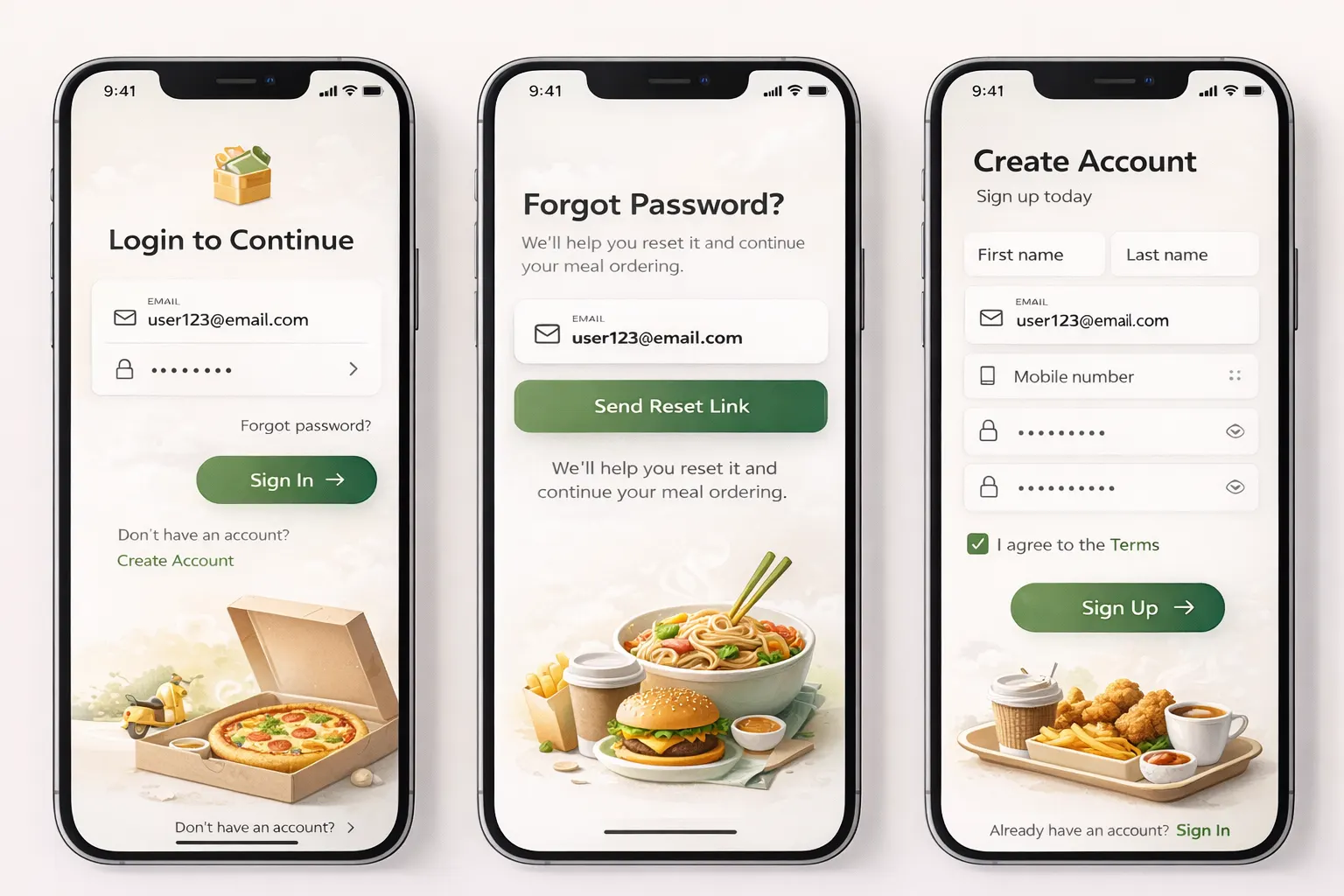
The customer app should support fast and secure onboarding across devices.
- Email, mobile, or social login: Enables quick and secure user access with minimal friction.
- OTP verification: Confirms user identity using one-time password authentication.
- Profile & address management: Allows users to save and manage multiple delivery addresses for home, work, or other locations.
Restaurant & Menu Browsing
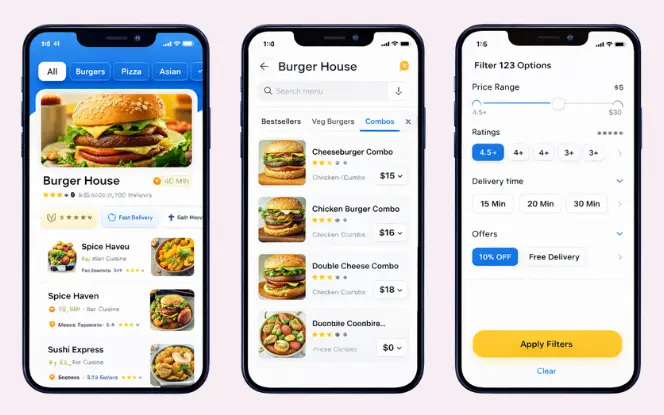
Users should be able to discover restaurants and dishes effortlessly using intuitive browsing tools.
- Browse by categories: Restaurants, cuisines, meal types, and dietary preferences.
- Filters & sorting: Filter by price, ratings, delivery time, offers, or distance.
- Menu browsing: View detailed menus with images, descriptions, pricing, and add-ons.
- Subcategories: Improve navigation (e.g., Burgers → Veg / Non-Veg / Combos), reducing search friction.
Smart Search with Auto-Suggestions:
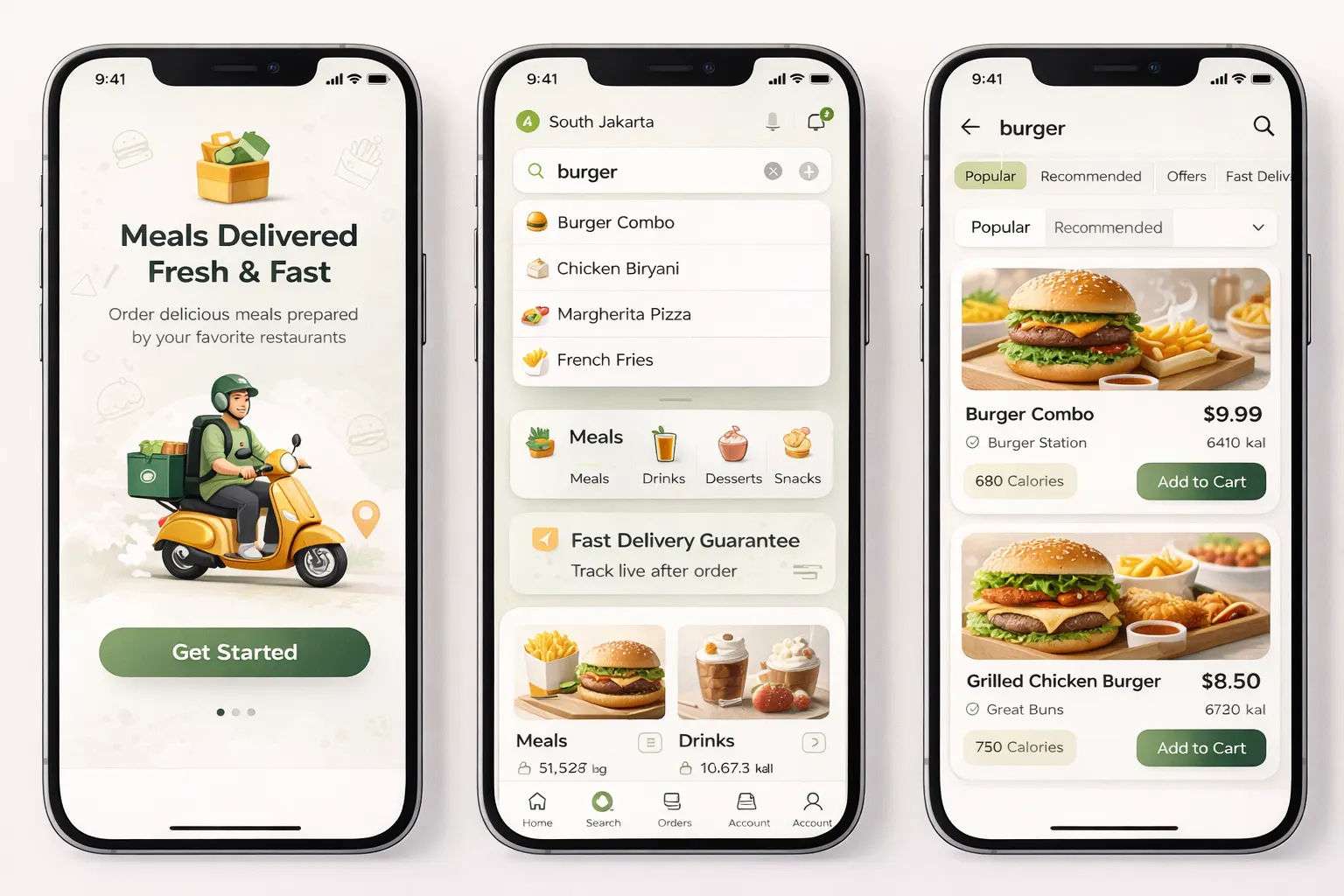
A powerful search experience helps users find food quickly and increases conversions.
- Auto-suggestions: Shows relevant restaurants and dishes as users type.
- Spell correction: Fixes typos to avoid zero-result searches.
- Trending searches: Highlights popular meals and restaurants in real time.
- Optional voice search: Enables hands-free searching, especially useful on mobile devices.
For fast-commerce UX inspiration, explore our guide on how to develop an app like Zepto.
Cart & Checkout Experience
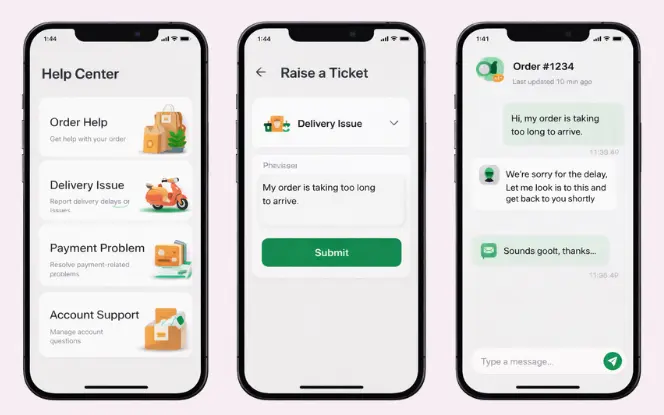
The checkout process should be fast, transparent, and flexible.
- Coupon & promo codes: Allows users to apply discounts during checkout.
- Delivery scheduling: Enables users to choose preferred delivery time slots.
- Itemized billing: Displays a clear breakdown of food price, taxes, delivery fees, and discounts.
- Multiple payment options: Supports cards, UPI, wallets, and cash on delivery.
Real-Time Order Tracking
Real-time visibility builds trust and improves user retention.
- Live GPS tracking: Allows users to track delivery partners on a live map.
- Dynamic ETA updates: Adjusts delivery time based on traffic and route conditions.
- Delivery partner details: Displays rider name, contact information, and delivery status.
This transparency significantly improves customer confidence and satisfaction.
Secure Payment Gateway Integration
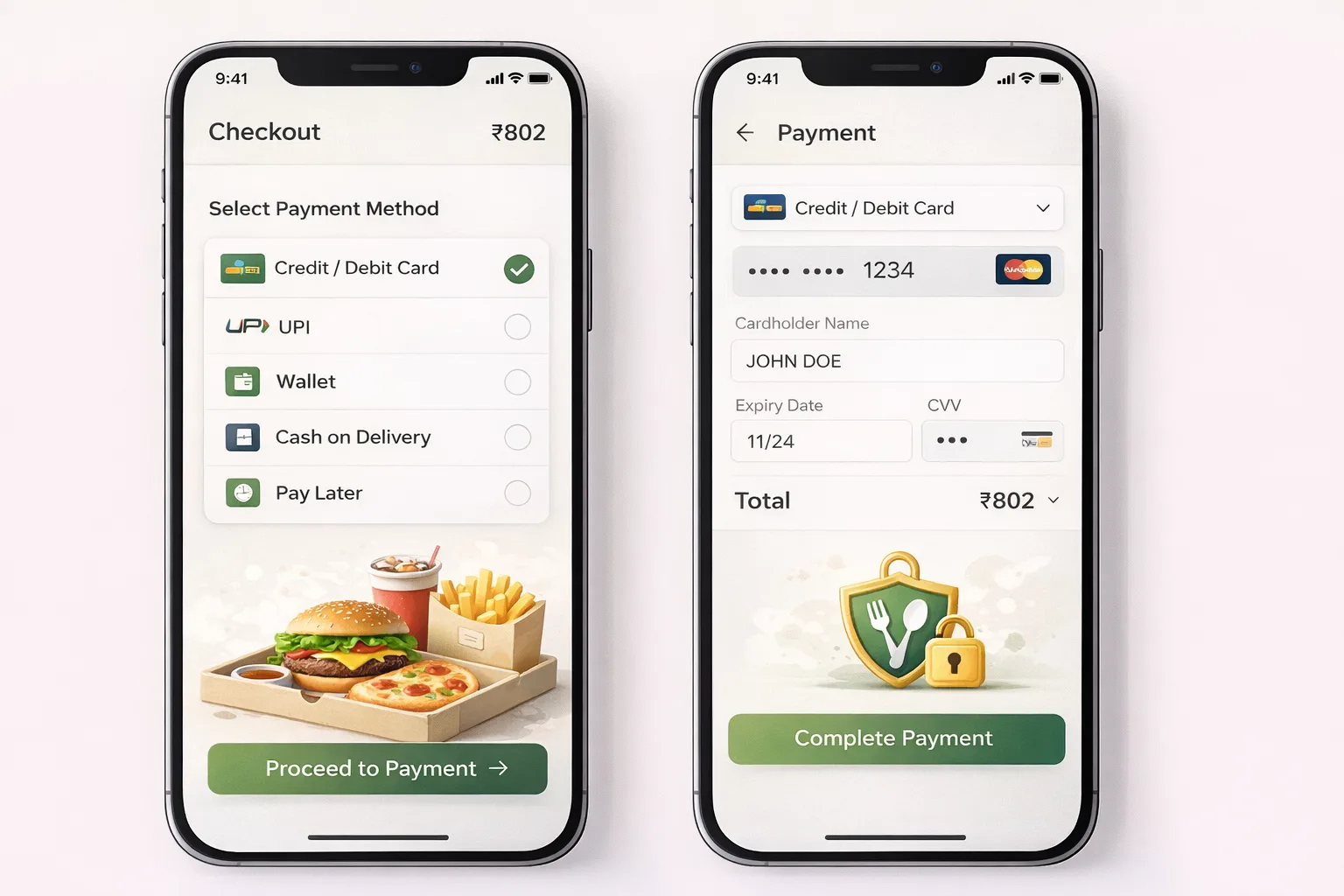
All transactions must be fast, secure, and compliant.
- UPI payments: Enables instant bank transfers with real-time confirmation.
- Debit & credit cards: Supports global card networks with secure processing.
- Digital wallets: Allows frictionless payments through popular wallet apps.
- Cash on delivery: Offers offline payment flexibility where required.
- Local payment gateways: Improves success rates by supporting region-specific providers.
All payments should be encrypted and PCI-DSS compliant to protect user data and financial information.
2. Delivery Partner App Features
The delivery partner app is designed to help riders accept orders quickly, navigate efficiently, and manage earnings transparently. These features directly influence delivery speed, operational efficiency, and overall food delivery app pricing.
Rider Registration & Verification
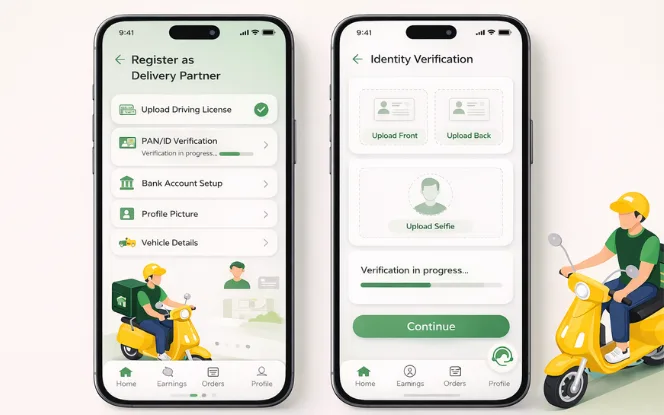
Ensures only verified delivery partners join the platform.
- Mobile number login with OTP: Enables quick and secure rider onboarding.
- Document verification: Supports ID, license, and vehicle verification for compliance.
- Profile management: Allows riders to update personal and vehicle details.
Order Request & Acceptance
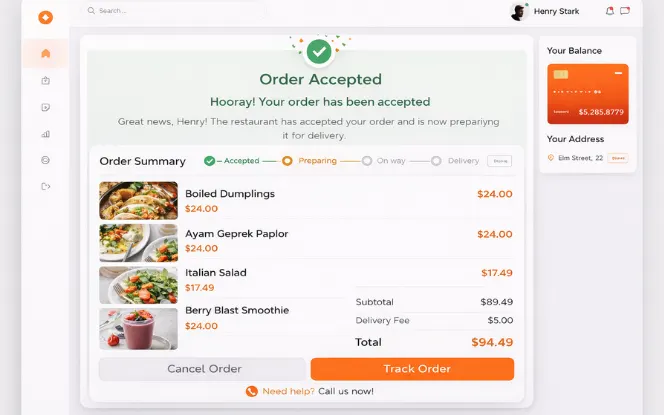
Enables fast order allocation and reduced delivery delays.
- Instant order notifications: Alerts riders about new delivery requests in real time.
- Accept or reject orders: Allows riders to manage availability and workload.
- Order details view: Shows pickup location, delivery address, and order value.
Route Optimization & Navigation
Improves delivery efficiency and reduces travel time.
- Optimized routes: Suggests the fastest delivery routes using real-time traffic data.
- In-app navigation: Provides turn-by-turn directions via integrated maps.
- Distance & ETA display: Helps riders plan deliveries more efficiently.
Order Status Management
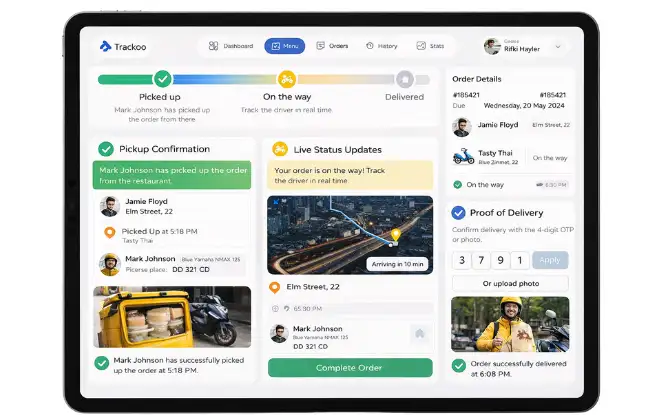
Keeps customers and restaurants informed throughout the delivery process.
- Pickup confirmation: Confirms food collection from the restaurant.
- Live status updates: Updates order progress (picked up, on the way, delivered).
- Proof of delivery: Confirms successful delivery via OTP or image upload.
Earnings & Wallet Management
Ensures transparency and motivates delivery partners.
- Daily, weekly, and monthly earnings: Displays income summaries in real time.
- Incentives & bonuses: Shows surge pricing, peak-hour bonuses, and rewards.
- Wallet & payout tracking: Tracks completed payments and pending settlements
Availability & Shift Controls
Helps riders manage work schedules efficiently.
- Online/offline toggle: Allows riders to control availability instantly.
- Shift scheduling: Supports planned work hours in high-demand zones.
- Heatmap visibility: Highlights high-demand areas for better earning opportunities.
In-App Support & Notifications
Ensures smooth communication and quick issue resolution.
- In-app chat or call support: Connects riders with support teams when needed.
- System alerts: Notifies about order updates, policy changes, and promotions.
- Emergency support: Provides quick access to help during delivery issues.
3. Admin Panel:
Admin Control
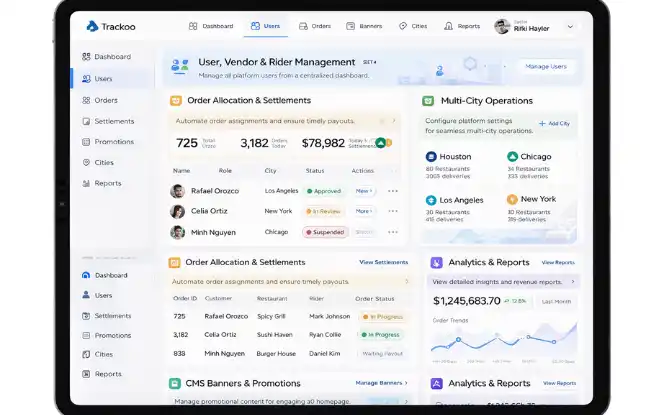
- User, vendor & rider management: Manages all platform users from a centralized dashboard, including onboarding approvals, access control, account status, and activity monitoring.
- Order allocation & settlements:
Controls order assignments and automates payment settlements between restaurants and delivery partners to ensure timely and accurate payouts. - Multi-city operations:
Supports seamless platform expansion across multiple cities with location-based configurations for pricing, delivery zones, and availability. - CMS banners & promotions:
Manages homepage banners, offers, featured listings, and promotional content to drive user engagement and conversions. - Analytics & reports:
Provides detailed performance insights, revenue reports, order trends, and operational analytics for informed decision-making.
Customer Support & Ticketing
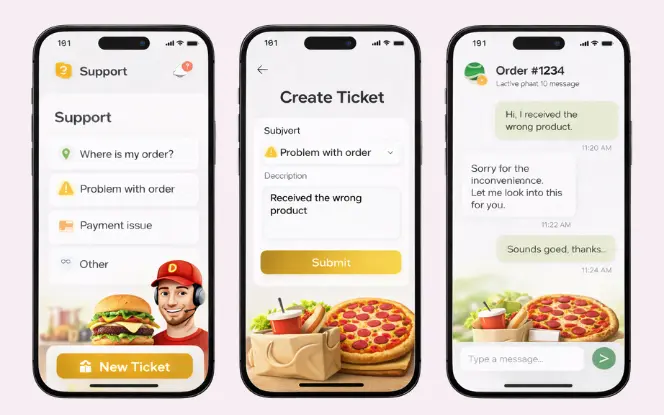
Integrate a ticketing system to manage user complaints and queries across all order stages. Support agents can view, assign, and resolve issues directly from a centralized dashboard.
- Order-based issue tracking:
Links customer issues directly to specific orders for faster resolution. - Live chat support:
Enables real-time communication between customers and support agents. - Auto-assignment to agents:
Automatically assigns tickets to available support staff to reduce response time. - Ticket status management:
Tracks issue progress from open to resolved for full transparency.
This system improves response time, operational efficiency, and overall customer satisfaction.
Technology Stack

The technology stack directly influences the performance and scalability of your app. A well-chosen stack ensures that your application can handle large traffic volumes and complex operations.
Common technologies used:
- Frontend: React Native or Flutter for cross-platform development
- Backend: Node.js, Django, or Ruby on Rails
- Database: PostgreSQL, MongoDB
- Cloud Storage: AWS, Google Cloud
- Payment Integration: Stripe, PayPal
Opting for these modern frameworks enables on-demand food delivery app development that’s scalable, fast, and secure.
Development Team Structure (And Why It Matters)

Who builds your app matters as much as what goes into it. A standard development team consists of:
- Project Manager
- UI/UX Designer
- Frontend Developer
- Backend Developer
- QA Tester
- DevOps Engineer
Hiring an experienced team from a trusted development company can increase initial expenses but ensures a high-quality product. A seasoned team understands how to build an app like Uber Eats efficiently, avoiding costly mistakes. Explore options in How to Choose the Right App Development Partner.
Security Measures
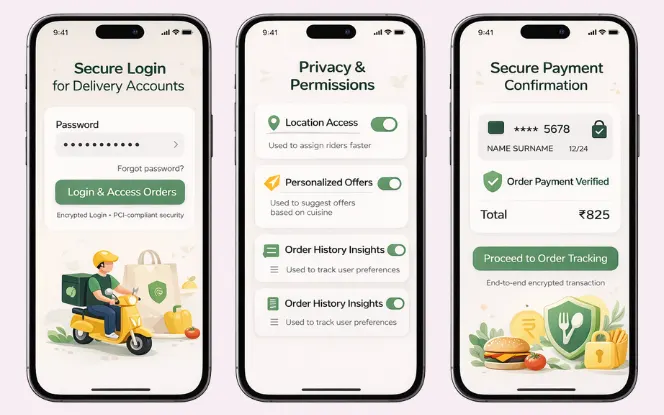
In an app where sensitive user data and financial transactions are involved, implementing robust security protocols is non-negotiable. Features like end-to-end encryption, two-factor authentication, and secure payment gateways can add 10-15% to your cost to develop a food delivery app.
Testing and Quality Assurance

QA is a vital phase in the development lifecycle. It ensures that your app is bug-free, user-friendly, and performance-optimized. The process includes:
- Functional Testing
- Security Testing
- Load Testing
- Cross-Platform Testing
Skipping thorough testing might reduce costs short-term but leads to poor user experience and eventual rework.
Post-Launch Maintenance

Your job doesn’t end at launch. You need to continually monitor server health, respond to user feedback, release updates, and fix bugs. Post-launch maintenance typically costs around 15-20% of the initial development cost annually. Learn about How much does it cost to develop app like Taskrabbit This is an often-overlooked factor in most food delivery app pricing guides, but it’s essential for long-term success.
Competitive Strategies to Build a Successful Uber Eats–Style Platform
Creating a food delivery app is no longer enough the market is highly competitive. To stand out, you must strategically optimize user experience, operational efficiency, and brand trust.
Below are key strategies used by globally successful delivery platforms.
- Build a Strong Restaurant Network: Onboard many restaurants early with diverse menus, wide coverage, exclusive deals, low commissions, fast onboarding, and POS support.
- Optimize Delivery Operations: Use smart routing, driver assignment, and heat maps to improve speed, cut costs, and boost driver earnings.
- Focus on User Retention: Drive repeat usage with loyalty points, subscriptions, personalized offers, promotions, and cashback partnerships.
- Prioritize Seamless UX: Simple UI, reliable payments, accurate tracking, and fast checkout reduce app uninstalls.
- Leverage Data & Analytics: Optimize pricing, menus, delivery supply, and customer targeting using real-time insights.
- Expand Regionally with Strategy: Localize language, currency, menus, regulations, and commission models for each market.
Why SDLC Corp Is a Strong Development Partner
Organizations worldwide choose SDLC Corp because we combine technical excellence, scalability engineering, and industry-specific expertise to build future-ready delivery ecosystems.
Here’s what sets SDLC Corp apart:
Proven Experience in On-Demand Delivery Platforms
SDLC Corp has delivered:
- Food delivery apps
- Grocery & medicine delivery platforms
- Multi-vendor marketplace solutions
- Real-time courier tracking systems
- Subscription-driven delivery models
Our teams understand the nuances of managing multi-sided marketplaces.
Expertise in Real-Time Systems & Scalable Architecture
Building an Uber Eats–style platform requires:
- WebSockets / MQTT
- Scalable microservices
- High-availability cloud setup
- Real-time push notifications
Our engineering team has deep experience with all these systems.
Transparent Pricing & Flexible Engagement Models
We adapt to your goals with:
- Fixed-price models
- Dedicated development teams
- Hybrid pricing models
- Roadmap-based phased delivery
This helps optimize cost and efficiency at every stage.
Enterprise-Grade Security & Compliance
We ensure your platform meets global standards:
- PCI-DSS payment security
- GDPR compliance
- Role-based access controls
- Encrypted APIs
- Secure Auth flows
This is essential for protecting financial data and user privacy.
Long-Term Support for Scaling & Expansion
We support:
- Ongoing maintenance
- Feature enhancements
- Server monitoring
- Load testing
- Multi-region deployment
This ensures your app grows smoothly from MVP to global scale.
A Partner, Not Just a Development Vendor
- Product strategy
- Feature prioritization
- Monetization guidance
- Market adaptation support
This helps clients reduce risk and accelerate time to market.
Conclusion
Building a food delivery app like Uber Eats involves careful planning across design, development, testing, and maintenance. Understanding the cost breakdown helps you align your budget with your goals, whether you’re launching an MVP or a full-scale platform.
Need expert guidance?
Contact SDLC Corp a leading food delivery app development company to get a tailored quote and end-to-end development support to turn your food delivery app idea into a scalable, high-performing solution.
FAQs
How much does it cost to build a food delivery app like Uber Eats?
The cost ranges from $10,000–$20,000 for an MVP, $20,000–$40,000 for a mid-level app, and $40,000–$80,000+ for an enterprise platform.
What are the essential features of a food delivery app?
How long does food delivery app development take?
Do I need separate apps for customers, restaurants, and drivers?
Is custom development better than using a clone script?
Why should I choose SDLC Corp as a food delivery app development partner?
SDLC Corp provides:
- Proven expertise in real-time delivery ecosystems
- Scalable microservice architecture
- PCI-DSS secure payment flows
- Transparent pricing and flexible engagement models
- Long-term maintenance + cloud deployment support

